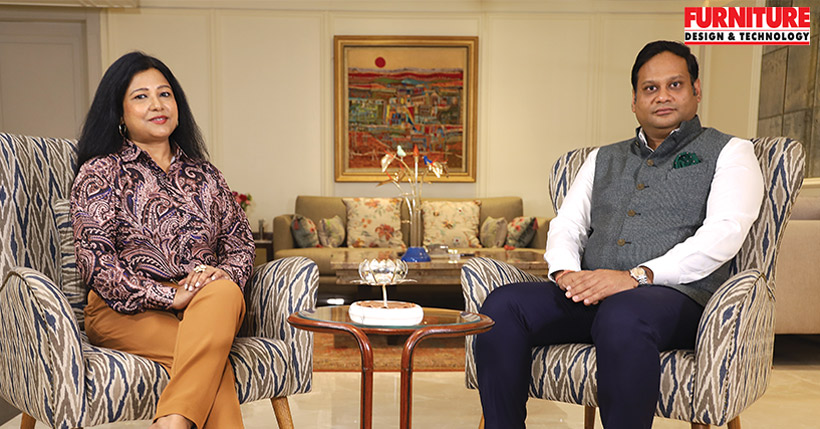
In a conversation with Verticaa Dvivedi, Editor-in-Chief, FURNITURE DESIGN & TECHNOLOGY (FDT), Mohit Singla, Chairman, Trade Promotion Council of India (TPCI) speaks on how strategic alliances with major industry players and the establishment of innovative clusters are poised to elevate India’s furniture manufacturing landscape, boosting exports and fostering economic growth.
I’D LIKE TO KNOW ABOUT THE TRADE PROMOTION COUNCIL OF INDIA’S PARTNERSHIP WITH THE WORLD FURNITURE CONFEDERATION. HOW DO YOU THINK THIS IS GOING TO TRANSFORM INDIA’S ORGANIZED MANUFACTURING SECTOR IN FURNITURE?
In 2019, TPCI, during one of its committee meetings, realized, based on a report on export competitiveness, that China exports almost $100 billion worth of furniture, making it the second largest exported commodity from China. In contrast, India was exporting only around $800 million, which is just 0.7% or 0.8% of this total value. Considering India’s skilled manpower in the furniture sector, we saw potential for significant growth. We reached out to the Embassy of India in Beijing and lobbied to get India a membership in the World Furniture Confederation, headquartered in China. This was a significant achievement, but work stalled due to COVID-19 in 2020, 2021, and 2022. However, in 2023, during the Annual General Meeting of the World Furniture Confederation in Guangdong, China, we signed a MoU with the Chinese National Furniture Association to set up a furniture cluster in India. This was the start of our journey, and we now have multiple MOUs with various countries, showcasing India’s potential and buying power. This effort aims to bring the Indian furniture sector into a more organized economy.
WHERE CAN WE EXPECT TO SEE THE CLUSTERS?
The concept of clusters is relatively new in India. As announced by the Prime Minister in 2022, furniture is one of the 12 champion sectors. Initially, we are focusing on Northern India, specifically Rajasthan or Punjab, due to their good connectivity with airports. This will allow designers and direct customers to visit the clusters easily, spend time, and see the factories and retail atmosphere.
.jpg)
RECENTLY, YOU SIGNED A MEMORANDUM OF UNDERSTANDING WITH FEDERLEGNOARREDO ITALY. CAN YOU TELL US ABOUT THAT MOU AND ITS POTENTIAL IMPACT ON THE INDIAN FURNITURE SECTOR?
Our first MOU was with the China National Furniture Association, the largest furniture association globally, with 56 clusters. Following this, we signed MOUs with Thailand, Vietnam, Indonesia, and Cambodia, covering major Asian furniture manufacturing countries. We were focusing on the European Furniture Industry Consortium as well; Italy became the first European country we signed an MOU with, it will soon be followed by Germany and Poland. The aim is to garner support from all furniture manufacturing countries, educate them about business potential in India, and create a collaborative economy. By bringing their expertise, skills, and design methodologies to India, we hope to create a vibrant economy and help the Indian furniture sector thrive.
THE FURNITURE EXPORT MARKET IS DOMINATED BY A FEW COUNTRIES. WHAT IS THE COUNCIL DOING TO ENSURE THAT INDIA GAINS A SIGNIFICANT SHARE?
Currently, China exports around $100 billion worth of furniture, with $50 billion bought by the US. Interestingly, Vietnam, which started its furniture manufacturing sector just ten years ago, now exports over $9 billion worth of furniture. Vietnam’s success is attributed to creating efficient clusters that manufacture cost-effective furniture tailored for specific markets. They got a significant share of the US market from China; the duty structure too helped them. India too with its numerous free trade agreements has the potential to emerge as an export hub for the furniture sector. Thanks to our skilled manpower and competitive ecosystem for fabrics and materials, we can become a formidable player in the global export market. Our strategy involves developing clusters to replicate this success and substantially enhance India’s furniture exports.
WHAT IS THE STATUS OF THE PLI SCHEME IN THE FURNITURE SEGMENT?
The PLI scheme for the furniture sector was considered alongside the announcement that furniture would be a champion sector. While Indian furniture exports haven’t grown significantly, a PLI scheme could boost exports. It’s crucial for the furniture industry to unite, set targets, and lobby for the PLI scheme. TPCI is ready to assist and advocate for this initiative to the government.
WHAT MESSAGE WOULD YOU LIKE TO GIVE TO FURNITURE MANUFACTURERS, EXPORTERS, AND DESIGNERS IN INDIA?
I want to convey that the furniture industry in India is a sunshine sector with huge global demand and high profitability. We must unite, formalize an organized economy, and create a competitive edge for Indian products in the global market. By focusing on good design, quality, and competitiveness, the furniture sector can become a significant contributor to India’s GDP. It’s time for the industry to come together and seize this opportunity.
Furniture Design India and the magazine FURNITURE DESIGN & TECHNOLOGY (FDT magazine) are from the trusted 22-year-old media house of SURFACES REPORTER and PLY REPORTER.
FDT is a B2B monthly bilingual magazine from India that shares the pulse of the furniture business in India and connects the manufacturers, OEMS, product designers, architects, showrooms, designers and dealers.
Read More© 2025 Furniture Design and Technologies.. All Rights Reserved. Developed by eyeQ Advertising